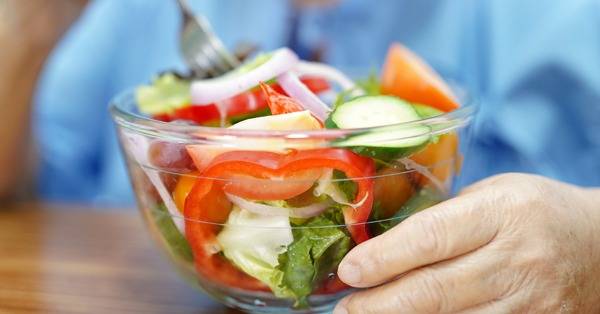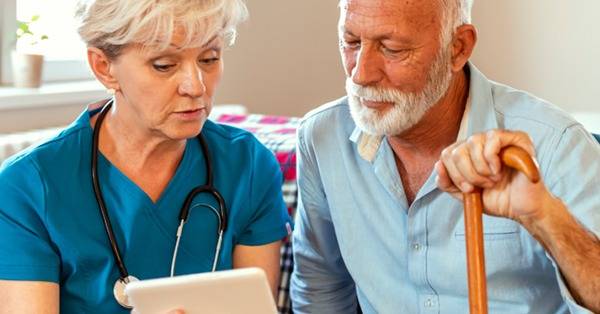- Solutions
- Solutions
- Home Health
- Hospice
- Life Plan Community
- Palliative Care
- Private Duty
- Senior Living
- Skilled Nursing
- Skilled Nursing
- Skilled Nursing Software
- Advanced Insights
- Customer relationship management
- Data and analytics
- Financial & operations management
- Marketing
- Nutrition management
- Referral management
- Regulatory compliance
- Retail management
- Resident engagement
- Revenue cycle management
- Skilled nursing interoperability
- Partners
- Blogs
- Resources
- About

8 key ingredients for a successful senior nutrition program
It’s no secret that nutrition safety and quality are vital to any senior housing organization. A good senior nutrition program not only helps improve resident satisfaction and occupancy rates but also contributes to residents’ overall health and wellbeing.
Of course, it’s also no secret that senior housing staff faces significant challenges running an effective nutrition management program in today’s environment. From supply chain issues to labor shortages to rising food costs, the pressures on dining operations are unprecedented.
But there is a secret ingredient that can help meet these challenges. Automated nutrition management tools, especially when integrated with an electronic health record (EHR) system can improve staff efficiency, and resident safety, and reduce food waste to lower costs. Here are eight ways technology can make your nutrition management program a success.
Monitor and manage your supply chain
Your supply chain extends beyond your distributors. It includes the agricultural teams that produce food and the people who process and package food for shipment. It includes the people providing transportation that brings food to your distributors, who then deliver it to your senior community. Every part of this chain is experiencing staff shortages, high fuel prices, and strains on their respective supply chains.
Use technology to track your expected deliveries, and to see where there could be changes or delays. Talk with your food vendor to share information and evaluate what they have on supply that can work with your menu. Add flexibility by shortening your menu cycle from four weeks to two weeks. This will give you more accurate information about what supplies will actually be available. And if you find you need to switch the brand of a particular food item, use technology to ensure the product yield and nutrient yield are what you need.
Help staff work smarter, not harder
It’s crucial right now to make staff as efficient as possible because staffing is in crisis. Effectively using technology is one way to ease the burden on your staff. Automating tasks that used to be done manually—like hand-writing menu selections and counting tallies—not only saves time but also can improve accuracy. When you need to recalculate serving amounts due to a census change or a product change, technology can automatically adjust recipes so your staff can seamlessly deliver meals to your residents.
Monitor availability and improve cost-efficiency
As supply chain and staffing issues persist, some vendor partners offer fewer products to compensate. And in some cases, these vendors don’t receive shipments they anticipate, meaning dining operators may need to quickly pivot and use a different ingredient or different supplier to meet their needs. Technology has helped many organizations manage those challenges.
In addition, because food costs are rising, it’s important that the efforts of the great cooks and chefs who work in our senior housing communities aren’t wasted. Technology can provide accurate tracking so dining staff knows how much to produce and when. The level of detail and the flexibility a technology solution delivers can reduce waste and improve the accuracy of the meals you produce every day.
Swiftly adapt to changes
The onset of the COVID-19 pandemic offered a lesson in the need for agility. Dining operators had to quickly and completely change how they served resident meals, which meant re-thinking not only how to deploy staff but also food production details and ensuring they still met resident needs and preferences. Facilities with nutrition management systems in place went online and simply adjusted the location where meals were being served—from the communal dining room to individual residents’ rooms. Using a mobile tool allowed the nurse (the only one allowed in the room at this point) to enter meal preferences on the tablet. It changed how they operated, and some of those methods are still being used today because it was a real benefit for staff and residents.
Engage and retain your staff
It’s become normal for people to use their phones and tablets to stay connected, both at work and at home. So it’s attractive for your staff when you can offer technology that makes their job easier and more efficient. Using a mobile device to be able to turn in reports, eliminate hand counts, and work more efficiently in other ways that benefit them every day helps keep them engaged and interested in the work they do for you.
Accurate menus keep residents safe
There are two ways technology can help make sure your residents’ meals meet their individual needs. First, technology makes it easy to review and update allergies and therapeutic needs to ensure residents are getting safe and appropriate nutrition, including any consistency modification. Second, technology is especially powerful when it’s integrated with the EHR. That can reduce miscommunication, a missed diet requisition slip, or notification that a resident shouldn’t have a tray because they’re scheduled for a procedure. It’s imperative to use technology to its fullest extent to keep everyone safe.
Enhance overall resident experience and wellness
When restaurants started displaying nutrition information on their menus, that set a new expectation about choosing meals that meet an individual’s health needs and goals. The right technology can empower residents to make decisions not only about their meals but also about the time they prefer to eat. This helps keeps them engaged and feel more at home. And in some cases, technology can even narrow the selection presented to include only those options that align with a resident’s health needs.
How technology can help meet regulatory requirements
Regulations require menu plans that meet residents’ nutritional needs. Considering the combined challenges of sourcing food, managing costs, and meeting nutritional needs, it’s important to use technology to automate and calculate the specifics of each menu. If there’s a shortage of a specific item, users can quickly update recipes with a different ingredient and the nutrition information automatically updates as well. Because regulatory agencies monitor the nutritional adequacy of your menus, it’s important to have that information at your fingertips.
Find the right partner
Technology can enable efficiency and help you face today’s industry challenges. It’s important to partner with technology providers who understand the various types of integration that are available and how those can help your senior nutrition program.
See how our nutrition management solution can work for your senior nutrition program.
See what MatrixCare can do for you
Amy Wooton
Amy Wooton, RDN, is a registered dietitian licensed in the state of Florida with over 18 years of experience in clinical nutrition leadership for senior communities as well as acute care, food service management, nutrition informatics, and wellness education. Amy is an active member of the Academy of Nutrition and Dietetics, was appointed Vice Chair on the Interoperability and Standards Committee, and is the leader of the Academy’s Nutrition Care Process Workgroup. Amy most recently accepted a Leadership Award from the Florida Academy of Dietetics. She has achieved years of diversified experience in all spectrums and disease improvement and prevention throughout each lifespan. Amy is a dedicated leader and is passionate about the success of nutrition interventions as an electronic solution to healthcare crises.
Related Posts



See MatrixCare in action
Start by having a call with one of our experts to see our platform in action.
MatrixCare offers industry-leading software solutions. Thousands of facility-based and home-based care organizations trust us to help them improve efficiency and provide exceptional care.
© 2024 MatrixCare is a registered trademark of MatrixCare. All rights reserved.





